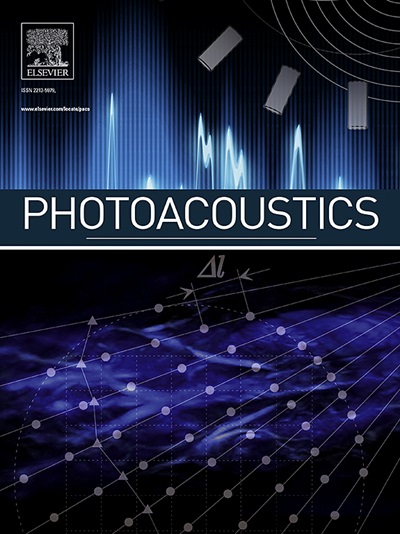光声断层成像的超稀疏重建:利用增强分数扩散模型的Sinogram domain prior-guided method
IF 6.8
1区 医学
Q1 ENGINEERING, BIOMEDICAL
引用次数: 0
摘要
光声断层成像是一种新型的非侵入性成像方式,结合了光学和声学成像的原理,用于生物医学应用。在稀疏视图采样导致光声信号采集不足的情况下,传统的直接重建方法会显著降低图像分辨率并产生大量伪影。为了消除这些限制,提出了一种基于增强扩散模型的图像域先验引导的超稀疏图像光声层析成像重建方法。该模型从全环512投影下的图数据分布中学习先验信息。在迭代重建中,先验信息作为最小二乘优化的约束,促进收敛到更合理的解。该方法的性能通过血管模拟、模拟和体内实验数据进行了评估。随后,通过延迟和方法将重构的正弦图转换到图像域,从而可以对所提出的方法进行彻底的评估。结果表明,与U-Net方法相比,该方法性能优越,生成的图像质量明显提高。值得注意的是,对于32个投影下的体内数据,与U-Net方法相比,sinogram structure similarity提高了~ 21 %,而与U-Net方法和delay-and-sum方法相比,图像结构similarity分别提高了~ 51 %和~ 84 %。光声层析成像在正弦图域的重建增强了稀疏视图成像能力,潜在地扩展了光声层析成像的应用。本文章由计算机程序翻译,如有差异,请以英文原文为准。
Ultra-sparse reconstruction for photoacoustic tomography: Sinogram domain prior-guided method exploiting enhanced score-based diffusion model
Photoacoustic tomography, a novel non-invasive imaging modality, combines the principles of optical and acoustic imaging for use in biomedical applications. In scenarios where photoacoustic signal acquisition is insufficient due to sparse-view sampling, conventional direct reconstruction methods significantly degrade image resolution and generate numerous artifacts. To mitigate these constraints, a novel sinogram-domain priors guided extremely sparse-view reconstruction method for photoacoustic tomography boosted by enhanced diffusion model is proposed. The model learns prior information from the data distribution of sinograms under full-ring, 512-projections. In iterative reconstruction, the prior information serves as a constraint in least-squares optimization, facilitating convergence towards more plausible solutions. The performance of the method is evaluated using blood vessel simulation, phantoms, and in vivo experimental data. Subsequently, the transformation of the reconstructed sinograms into the image domain is achieved through the delay-and-sum method, enabling a thorough assessment of the proposed method. The results show that the proposed method demonstrates superior performance compared to the U-Net method, yielding images of markedly higher quality. Notably, for in vivo data under 32 projections, the sinogram structural similarity improved by ∼21 % over U-Net, and the image structural similarity increased by ∼51 % and ∼84 % compared to U-Net and delay-and-sum methods, respectively. The reconstruction in the sinogram domain for photoacoustic tomography enhances sparse-view imaging capabilities, potentially expanding the applications of photoacoustic tomography.
求助全文
通过发布文献求助,成功后即可免费获取论文全文。
去求助
来源期刊

Photoacoustics
Physics and Astronomy-Atomic and Molecular Physics, and Optics
CiteScore
11.40
自引率
16.50%
发文量
96
审稿时长
53 days
期刊介绍:
The open access Photoacoustics journal (PACS) aims to publish original research and review contributions in the field of photoacoustics-optoacoustics-thermoacoustics. This field utilizes acoustical and ultrasonic phenomena excited by electromagnetic radiation for the detection, visualization, and characterization of various materials and biological tissues, including living organisms.
Recent advancements in laser technologies, ultrasound detection approaches, inverse theory, and fast reconstruction algorithms have greatly supported the rapid progress in this field. The unique contrast provided by molecular absorption in photoacoustic-optoacoustic-thermoacoustic methods has allowed for addressing unmet biological and medical needs such as pre-clinical research, clinical imaging of vasculature, tissue and disease physiology, drug efficacy, surgery guidance, and therapy monitoring.
Applications of this field encompass a wide range of medical imaging and sensing applications, including cancer, vascular diseases, brain neurophysiology, ophthalmology, and diabetes. Moreover, photoacoustics-optoacoustics-thermoacoustics is a multidisciplinary field, with contributions from chemistry and nanotechnology, where novel materials such as biodegradable nanoparticles, organic dyes, targeted agents, theranostic probes, and genetically expressed markers are being actively developed.
These advanced materials have significantly improved the signal-to-noise ratio and tissue contrast in photoacoustic methods.
 求助内容:
求助内容: 应助结果提醒方式:
应助结果提醒方式:


